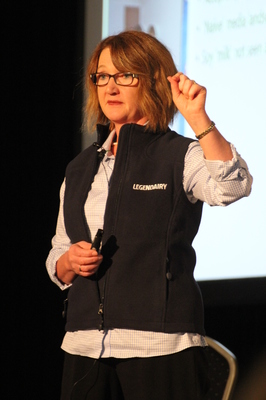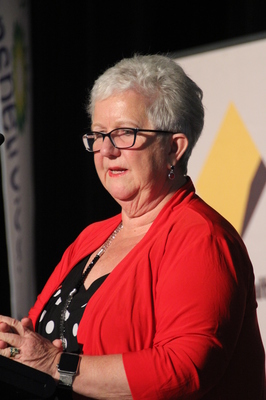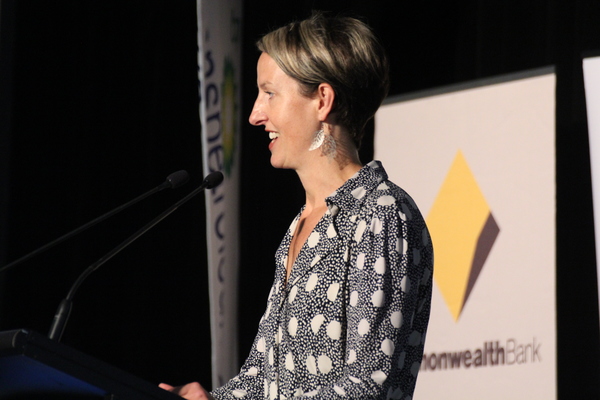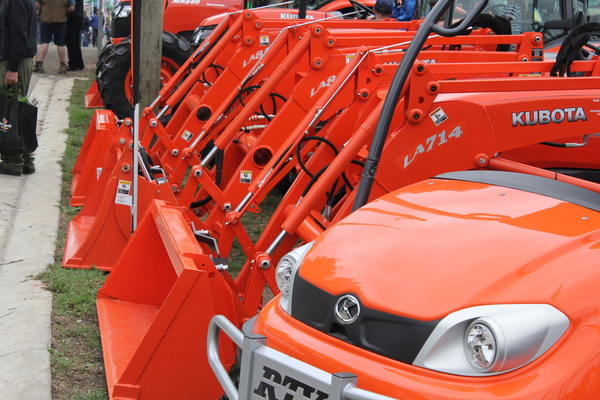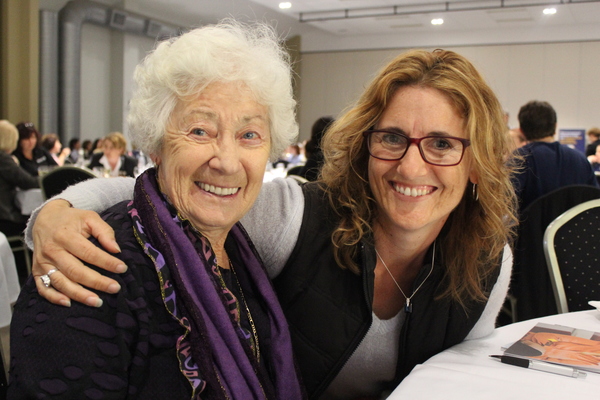
On the Thursday each year of the Farm World calendar, the ‘Women in Agriculture’ event takes centre stage at Lardner Park in Warragul. RUSSELL BENNETT went along late last week to hear the stories of three remarkable women involved in the farming industry.
“While I love my new rural life and the stories I’m starting to become part of, I never predicted that farming would become so prominent in my future.” – Dr Sinead De Gooyer
THOUSANDS upon thousands flock to Farm World at Lardner Park every year – widely considered to be Victoria’s largest regional agricultural event.
Farm World gives customers access to more than 700 exhibitors launching new products, showcasing existing ranges, and highlighting the latest in farming innovation.
But the event, now in its 54th year, also gives visitors the chance to hear from a range of truly inspirational people involved in the industry and learn from their stories of persistence, resilience, courage, and – ultimately – success.
The Commonwealth Bank and their ‘Women in Focus’ team have supported the Women In Agriculture event on the Thursday each year since it was first held in 2012.
In addition to the bank, Angela Betheras – the chair of Lardner Park Events – also thanked GippsDairy and Dairy Australia, who through their ‘Legendairy’ program supported the Farm World 2016 theme – ‘Dairy: an industry on the move’.
Thursday’s program linked in with the dairy theme and highlighted the resilience and pride of Australia’s dairy industry.
The dairy industry is Gippsland’s largest agricultural commodity and accounts for over 20 per cent of Australia’s milk supply.
Kelly Ward was the first speaker on Thursday’s agenda. She is Dairy Australia’s industry promotions manager and is a strategic communications specialist with an interest in implementing social marketing campaigns to promote behavioral change. Among other things, she is responsible for the communications to support the Legendairy campaign rollout.
In thinking about the women in agriculture topic, Kelly thought of the Henry Lawson story ‘The Drover’s Wife’, and a Russell Drysdale painting from the 1940s that – to her – say a lot about Aussie women.
“It just says so much to me,” Kelly said.
“It says ‘resilience’, ‘adaptability’, ‘nuturing’, ‘innovation’ … she’s a problem solver.
“Sometimes she’s a cheerleader for the rest of the family. These are all these qualities that I think the Aussie woman has always had. Deep down she’s also a gentle soul.
“(And) The Drover’s Wife is an amazing story of a true Aussie woman.
“I believe those qualities are still part of the job description today for all of you in this room. Things have been modernised – they’ve changed a little bit – but those innate qualities of who we are as women in agriculture, and regional women, are still there. They’re still the same – nothing’s changed.”
Kelly worked on the launch of the very first ‘National Healthy Bones Week’ in the 1990s.
“It was one of the first public health education weeks in Australia, but things were so much simpler then,” she explained.
“These were there days when you could actually fill a Clark Rubber pool with milk and actually get a radio station to do an outdoor broadcast asking people to swim across that pool on a winter’s morning to win cash. The connection was that it was the amount of milk we should all be drinking per year.
“It was also the time when you could put a bloke in a bath full of yoghurt and get coverage for it to symbolize the amount of yoghurt that Australian men were consuming at the time. Public relations for dairy was so much easier – we had a simple message … we grew up with it.”
But over time, that message became tougher to deliver.
The simple idea of having three serves of dairy per day was suddenly being challenged, while fad diets and confusion surrounding dairy had started to gain more coverage – particularly through social media streams.
Dairy Australia had a problem and they needed to find a solution.
“The fact is, we’ve got an amazing product and amazing people in this industry who’re doing a bloody good job,” Kelly said.
“They’re legendary, and from that the Legendairy campaign was born.”
Janet Moxey, from Moxey Farms in Gooloogong in central New South Wales, also spoke at Thursday’s function. Following her husband’s death 15 years ago, she’s taken an active role in agri-politics, including being a board member of Australian Dairy Farmers and the first female vice-president of the New South Wales Farmers Association.
Janet’s family originally farmed for three generations on the outskirts of Sydney before “residential pressures and the change of urbanisation in the area” saw them move out to Gooloogong about 18 years ago. They’ve since grown the farm to 3000 hectares, including milking 3800 head of cattle.
The final speaker on Thursday was Dr Sinead De Gooyer – a doctor and dairy farmer from South Gippsland who’s also a director of GippsDairy and the Gippsland Primary Health Network. Along with her husband and three children, she operates a share-farm at Korumburra. She’s a GP at Leongatha, with a focus on mental and adolescent health.
“My name is Sinead and I am a very ordinary, working mum,” she said, introducing herself to the room.
“But I’m also a very proud rural woman and it’s an absolute honour to be standing here today sharing some of my thoughts on life and the juggle that every single one of us in this room deals with on a day-to-day basis.
Sinead and her family have been share farming in South Gippsland since 2009 and they’re currently milking 480 cows on their property.
Originally from the UK, Sinead’s mother and father her and her three siblings moved to Australia when she was seven.
“From an early age I knew I wanted to be a GP,” she said.
“I guess I was stubborn, fortunate and lucky enough to make this dream a reality.
“(But) it wasn’t until I was probably halfway through my medical course that I realised I wanted to be a rural GP. What inspired me was an absolutely fantastic rural rotation I had with a GP in central Victoria. This was a bloke who was absolutely committed to ensuring that his rural community had access to really high-quality healthcare. The other thing that inspired me about that was that he was really a part of his community. It was that sense of community and sense of belonging that really took my interest.”
In 2003 after she completed her medical degree and a couple of years in inner-city hospitals, Sinead took up a position in Timboon – a town with a population of about 800.
“This move really marked the start of my adventure that lead me to standing up here today,” she said.
“As a new GP in a rural town, you get your fair share of pap-smears. Over that 12 months I had the privilege of listening to the stories of literally hundreds of women as they came in for their pap-smears, for their pill scripts, for their repeat scripts, with their kids, and for a variety of other issues. I guess what struck me in those first few months was the no-nonsense approach to life and the resilience and strength these women had.
“I remember at the time wondering if this came from the fact that they led such busy lives and wore multiple hats, or was it actually the norm in rural areas where generations of women had kept the community on every level ticking over? I just wasn’t sure.”
This year, on International Women’s Day, Sinead took the opportunity to really reflect on her life and the women who constantly inspire her – her mother, her sister, her neighbour.
“While I love my new rural life and the stories I’m starting to become part of, I never predicted that farming would become so prominent in my future … but then I went and fell in love with a country boy with a ute,” she said.
Nine months after they got married, her husband – a vet – voiced his long-held dream of milking cows. By Sinead’s own admission, it took about two years for her to get her head around the idea.
The couple and their young family have faced more than their fare share of obstacles along the way, such as losing their home in the Black Saturday bushfires just a couple of months before moving on to their first share farm – a time when Sinead was also heavily pregnant.
“It could have all very easily fallen apart at this point, but in fact it went the other way,” she said.
“It was obviously a period of massive re-adjustment and one of my most vivid memories was sitting in the bathroom bathing my eldest, looking out at the pouring rain and Googling ‘Dairy Farmer wife support group’. Through no fault of their own, my usual support network just didn’t get it. What helped me at the time though were the chats I had with other farming women – women in my situation who were juggling farm and family, and work
“At the end of that year, I had one of those moments where it just clicked. Throughout my transition into farming life, I had continued to work as a GP and I currently work three days a week as a GP in Leongatha, where I’ve worked since we moved in 2009. I do love what I do, but I truly believe that my experience of the many challenges that have faced farming families, couples and businesses have made me a much better doctor.
“In my role as a GP I tend to see situations where there’s a crisis – family and relationship breakdowns, acute mental health issues, and quite serious physical concerns.
“What has become apparent to me in my time in general practice is that the farming community isn’t particularly good in prioritising its own health needs. The cows are inevitably in better shape than their owners.
“Rural people have worse health outcomes than their metro off-siders in almost every domain. Our rates of preventable hospital admission, of mental ill-health and suicide are fairly alarming.
“Standing here I’m the first to admit that there’s no easy fix.
“Sitting where I had, on both sides of the fence, I decided I could get involved and see what I could do to challenge and shift that cultural norm of keeping it together at all costs.”

